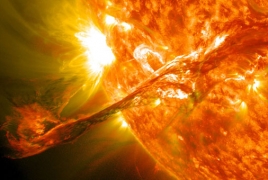The sun used to have a twin star named Nemesis June 15, 2017 - 15:05 AMT PanARMENIAN.Net - Astronomers have long been puzzled by the fact that our sun doesn't have a companion star. After all, most similar stars are part of a binary, or even triplet, system. Now, scientists may have confirmed a long-held theory: The sun did once have a companion star that has been dubbed "Nemesis," Engadget said. Scientists Sarah Sadavoy and Steven Stahler were studying the Perseus molecular cloud, packed with newly formed stars, to determine what percentage of stars like our sun form in pairs. (The young stars within Perseus are less than 4 million years old. Our sun, by comparison, is roughly 4.6 billion years old.) Their notion, that the majority of stars don't form as single stars, isn't new; the question is more about numbers. Just how many sunlike stars form as binaries? To find the answer, the scientists used existing data from a survey of every star in the Perseus stellar nursery. They ran a series of statistical models that took into account the numbers of both single stars and binary stars within the cloud. What they discovered surprised them: It appears as though all sunlike stars initially form as wide binaries, with 500 AU between them (a distance 17 times that of Neptune to our sun). Over the first million years of the stars' lives, the systems either shrink into a truly binary system or break apart, like our sun and Nemesis. But will we ever find our sun's lonely companion, Nemesis? It's unlikely. The press release states, in a melancholy fashion, "Based on this model, the sun's sibling most likely escaped and mixed with all the other stars in our region of the Milky Way galaxy, never to be seen again." While this study has fascinating implications for what we know about how stars are born, it also underlines the fact that there's still a lot left to learn about our own star; that's why NASA is launching the Parker Solar Probe, the first spacecraft to touch the sun's atmosphere, in 2018. Related links: Authorities said a total of 192 Azerbaijani troops were killed and 511 were wounded during Azerbaijan’s offensive. In 2023, the Azerbaijani government will increase the country’s defense budget by more than 1.1 billion manats ($650 million). The bill, published on Monday, is designed to "eliminate the shortcomings of an unreasonably broad interpretation of the key concept of "compatriot". The earthquake caused a temporary blackout, damaged many buildings and closed a number of rural roads. Partner news |